Letters from Lodi
An insightful and objective look at viticulture and winemaking from the Lodi
Appellation and the growers and vintners behind these crafts. Told from the
perspective of multi-award winning wine journalist, Randy Caparoso.
Dispelling myths about wines and foods
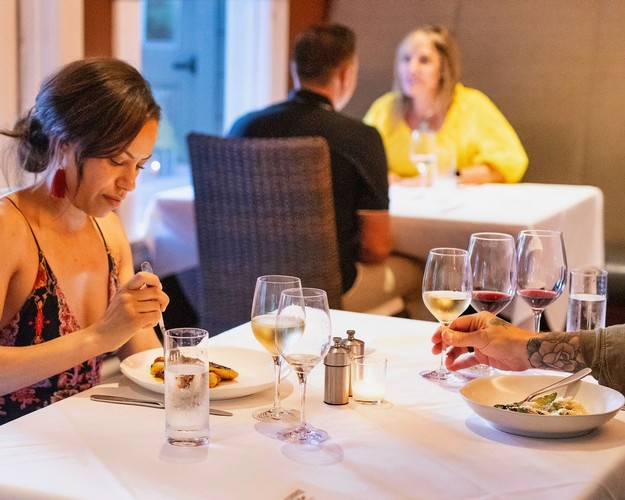
Guests enjoying multiple wines during dinner at Lodi's Towne House Restaurant. Jill Means Design.
Let's start off 2025 talking about something a lot of wine geeks seem to have little use for. Wine in the context of food.
Every ten or twenty years, or so it seems, the anti-food factions seem to pop up in the winosphere. Old-timers can even remember back in the 1980s when the famed wine critic Robert Parker used to rail against the very idea of "food wines." That is, lighter, more subtle wines that, theoretically, were made to have higher percentage chance of complimenting a wider range of foods. To Parker, those wines were just poor excuses for weak or uninteresting wines. C'est la vie.
To a certain extent, of course, to be oblivious to wine and food pairing "conventions," as one wine educator recently put it, is to live in your own state of bliss. It's a free country. There is nothing wrong with the “drink-whatever-you-like” approach when it comes to what you put on the table. The way I see it, it's not much different than eating in general: Whenever you’re hungry, just open up a favorite canned food or stop by the nearest fast food joint on the way home.
If, however, you prefer giving what you eat considerably more thought⏤planning your menu, weighing the proportions of herbs and spices, picking out vegetables at peak freshness and value prices⏤you know darn well that you’ll usually end up with something far more satisfying than what you get from a can, a frozen food section or drive-through.
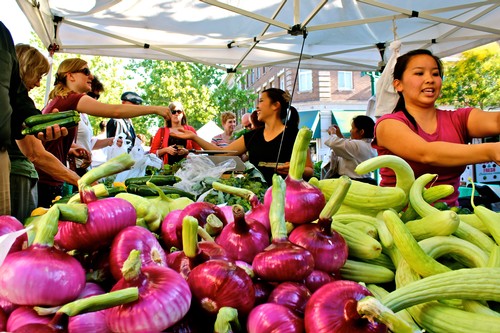
The importance of fresh, organic ingredients to much of the population: Lodi Farmers Market.
The same for wine: If you’re perfectly capable of picking out an ideal wine for your planned menu, then you know darn well you will probably get an even better meal than if you just pour whatever you happen to have hanging around. There is, after all, such a thing as ideal wine and food matches just as there are ideal ingredients to go in a dish, and the choices aren’t nearly as narrow as you may think.
In fact, the way many wines are made these days⏤calculated to attain an intensity that would please even a Parker subscriber while striking a finer sense of balance, thus a little more food versatility⏤the choices are even broader than the old so-called conventions; i.e., white-wine-with-fish and red-wine-with-meat.
The problem with the “old rules?” The fact that in numerous circumstances, red wines tastes wonderful with fish, and white wines are often rich and full enough for even red meats.
So the first thing you need to do, once you’ve made up your mind to pick out wines as lovingly and meticulously as items on your grocery store list, is to throw out those old rules, and to begin thinking more freely based upon principles of common sense, not what you’ve heard or read in some book.
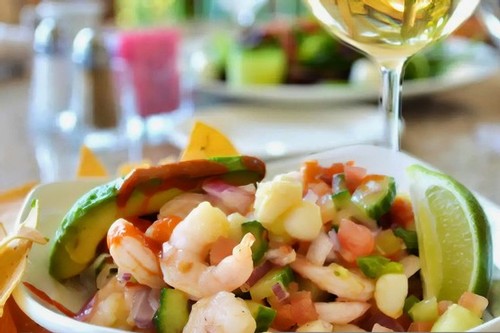
Shrimp seviche, a dish with specific wine affinities (whites sufficiently tart in acidity to balance citrus soaked seafood) notwithstanding anyone's drink-whatever-you-like mentality.
With that, here are some of those culinary myths that are better left dead and buried, along with some thoughts related to basic principles of sensible wine and food matching (for reference, see The Science and basic principles of wine and food matching). Those myths...
Myth: That “great” wines make the greatest food matches
In actuality, it is almost the opposite. Because I can’t put it any better, I’m going to let renowned wine author and importer Kermit Lynch (quoting from his Adventures on the Wine Route) explain this to us:
When a woman chooses a hat, she does not put it on a goat’s head to judge it; she puts it on her own. There is a vast difference, an insurmountable difference, between the taste of a wine next to another wine, and the same wine’s taste with food…
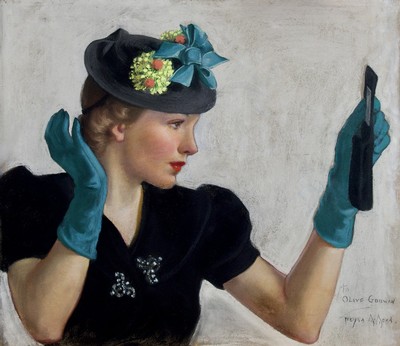
Woman's Home Companion, 1938. illustratedgallery.com.
Test it yourself. Take two impreccable wines, the Domaine Tempier Bandol rosé… and a bottle of Château Margaux, which many critics consider the finest Médoc of the day. Compare the two side by side. Award points. Do not be surprised if the Margaux wins handily. Now serve the same two wines with a boiled artichoke and rate them again. The Margaux is bitter and metallic-tasting, whereas the Bandol rosé stands up and dances like Baryshnikov… which is the better wine? Which wins?
In other words, a “great” wine that may rate a lofty 100-point score is neither here nor there when it comes to how it tastes with food. If you’re preparing a Peruvian style seviche, for instance, a lemony tart $14 bottle of Lodi Albariño has a far higher percentage chance of making an exciting wine match than a big, broad $40, 95-point Chardonnay. But if you’re stewing chicken with fresh herbs and dumplings, that $40 Chardonnay is guaranteed to taste a heck of a lot better than a big, oaky $100, 98-point Cabernet Sauvignon.
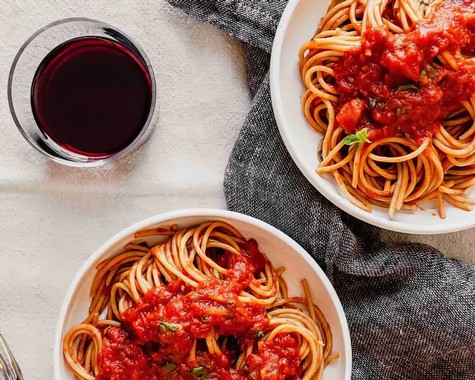
Spaghetti in zesty tomato sauce: There is a reason why light, acid driven red wines (not big, fat "great" wines) are best with this all-time favorite.
In turn, a light, zesty $12 Zinfandel or Sangiovese are a heckuva lot better tasting than that $100 Cabernet Sauvignon with a plate of spaghetti and meatballs, a cheesy burger or pizza. You know⏤the foods most of us actually eat, because we know and love 'em. Sensible foods taste best with sensibly chosen wines, which are usually the simplest and least expensive wines—the opposite of "great."
The examples of expensive, oversized "prestige" wines ruining a meal, at home or in a fancy restaurant, are endless. Ergo, those pesky wine and food "conventions" matter, after all.
Myth: That lighter style "food wines" are excuses for weak, inferior wines
If you take a look at many of the wines of the world in regions with the greatest, most time honored culinary heritages⏤such as Chianti in Tuscany, Sancerre in France, or the dry rosé culture of the French Riviera⏤you can see that the wines consumed there are actually quite light, easy to drink, and relatively lacking in the taste of oak or the feel of high alcohol that characterizes most of the "serious" wines of today.
Just because a wine is light in body and flavor doesn't make it inferior. The fact is, lighter, less expensive wines are more likely to go better with food just based on the fact that they are less likely to kill a dish, the way ketchup would on paté and brown gravy would on ice cream. Just because a wine is big and strong does not make it a better wine for your dish. This is why the great, light, easy drinking “food wines” of the world, both traditional and new, exist in the first place.
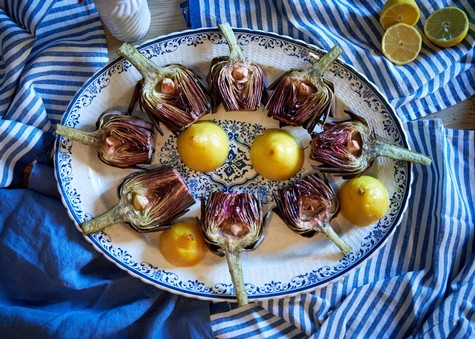
Roasted Provençal artichokes with garlic, lemon and olive oil—components that actually taste unpleasant with many wines, yet ideal with rounded wines made from grapes of Mediterranean origin. themediterraneandish.com.
Myth: That big "oaky" Chardonnays don't go with food
There’s a lot of reverse snobbism these days, saying that big, rich American style Chardonnays are uncool, or are just for the proverbial cougars sipping them like cocktails in bars. This is a shame because there are actually a lot of dishes with which a full bodied, even super-oaky style of Chardonnay⏤one loaded with not just sweet apple/pineapple flavors, but also vanillin, smoky or even charred tastes of barrels⏤would do a lot better than a lighter, pure fruit style of wine. Smoked or wood grilled meats, for instance, love a smoky, oaky wine. California Chardonnays tend to be quite full and richly oaked to the point of creaminess (or as they say, “buttery”), which is perfect for your everyday roasted chicken, dripping in naturally buttery, fatty juices.
Then there are pork roasts, braised veal, sautéed sweetbreads, wood grilled swordfish, salmon in poaching broths… the list of oaky Chardonnay lovin’ dishes goes on and on. In fact, there probably is no better wine for a holiday turkey⏤especially if cooked in a charcoal or wood roaster and stuffed with Chardonnay friendly sage, bread crumbs, and even seafood sausages or oysters⏤than any number of these "big, fat mamas," as one food writer once described California Chardonnays.
Ergo, there are also ideal food contexts for the heaviest and oakiest of wines.

Enjoying sharply dry whites with fish at Lodi's Towne House Restaurant. Jill Means Design.
Myth: That higher acid wines are always best for food
Wines with crisp, lemony sharp acidity are indeed wonderful for food; especially if you're having plainly cooked fish that an acidic white wine can zip up like a squeeze of fresh lemon. But put that same fish in a buttery sauce, or a rich, creamy or slightly salty shellfish stock reduction, and all of the sudden a high acid wine tastes thin and puckery, and the dish tastes oily and filling.
In other words, fatter low acid wines have as much a place with food as high acid wines. In fact, low acid wines are what traditional Mediterranean gastronomy is all about, which translates the same way for much of the cooking and wines of California, which is also dominated by a Mediterranean climate. When you look at most of the wines of Italy and Southern France, the vast majority of them are all fairly low in acid, and even "fat" with fruitiness, which only makes sense with foods driven by the taste of olive oil, plump beans and nostril tingling garlic.
Myth: That sweet wines interfere with the taste of food
In many cases, yes. But in many other cases⏤a sweet/sour/salty Chinese dish, chili spiked Thai food, a sweet/chili laced barbecue sauce, slices of cured peppery sausages, a salty baked ham glazed with pineapple, or even a pizza with sweet tomatoes and caramelized onions⏤wines with a touch of sweetness, such as a Moscato, a Symphony (a varietal specialty of Lodi) or even White Zinfandel, make a better balanced match than completely dry wines. Especially when dishes are really hot and spicy⏤in which case, slightly sweet wines can cool and freshen the palate in a way that dry wines can’t.
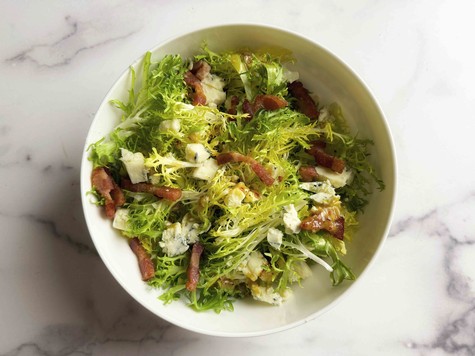
Frisée greens with Roquefort and lardons in a wine-like Sherry shallot vinaigrette, a natural match with fruit driven whites or soft, light, lively reds. cookswithoutborders.com.
Myth: That salads and vinaigrettes are bad for wine
Leafy greens tossed in harsh, acidic cider vinaigrettes are no good, with or without wine. But vinaigrettes made with soft, round, aromatic fine vinegars⏤such as balsamic, sherry, or rice wine vinegars⏤actually enhance, and liven up, the taste of wine. Throw in lush, vine ripened tomatoes, crunchy sweet onions, and salty, sensuous chunks of Roquefort, and you've got a fine match with off-dry white or pink wines made from Grenache, Zinfandel, Tempranillo, Pinot noir, or one of many black skinned grapes now used for fruit driven rosés.
How about the ever-popular Caprese salad (mozzarella di bufala, rounds of beefsteak tomato and ribbons of basil drizzled with pungent EVOO)… goodness, is there anything better than a softer styles of Pinot Grigio or airy light Picpoul Blanc? For salads made with fresh herb crusted goat cheese, it's hard to beat a crisp, dry Sauvignon Blanc. Throw whole grain mustard into the dressing, and top things off with shredded duck or slivers of cold beef, then light, fragrant, soft yet zesty reds made from Cinsaut, Grenache or the historic Mission grape come into play.
Bottom line: When it comes to salads, the choice of wonderfully matched wines is as endless as the delicious things you put into your salads.
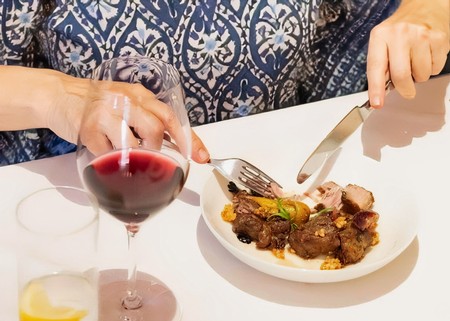
At Lodi's Towne House Restaurant, cutting into a leaner cut of meat with a savory sauce, better with a lighter, feminine style red than a big, rich, oaky one.
Myth: That the richest foods need the richest wines
This way of thinking will take you only so far. It works for red meats⏤big, rich, oaky Cabernet Sauvignons, Merlots or Petite Sirahs, for instance, are just right for fatty beef and lamb dishes. But when you slow-cook red meats, achieving more intense, caramelized, complex flavors, a round, soft, even feminine style of Pinot Noir, or a Lodi Zinfandel or Grenache, though, are more likely to beat out a big, brash Cabernet or Merlot any day. Make it a Coca-Cola pot roast, in all its caramelized juices, then bring out the light, sprightly, easy going Cinsaut or lower priced Zinfandel… so many rich and complex food settings in which bigger is not better.
For things like oysters, lobster, shrimp, crab and other sweet shellfishes, white wines that are fairly light, dry and crisp⏤such as Albariño, Grenache Blanc, Sauvignon Blanc, Fiano, Verdelho, Picpoul Blanc or Pinot Grigio⏤tend to make a fresher combination than thick, heavy Chardonnays. Spicy hot Asian seafood and vegetables dishes can be as rich as they come; and in this context, full alcohol (over 14% or 15% ABV), oaky whites usually taste harsh and bitter, whereas feathery light, lower alcohol whites⏤such as those made from Northern European grapes (i.e., Kerner, Riesling, Bacchus, Grüner Veltliner, etc.) grown in Lodi's Mokelumne Glen Vineyards⏤are more likely to soothe the palate, taming the hot sensations of exotic spices.
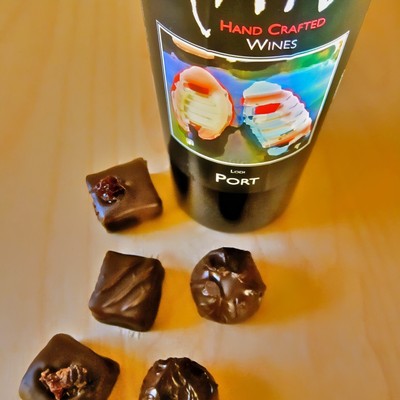
Myth: That chocolate is an "enemy" of wine
Many chocolate lovers swear by champagne style wines. Personally, I find most of them to be a little too dry and tart for chocolatey desserts. I will say, though, that anyone who hasn't had a ruby or tawny (i.e., wood aged) Port with dense, bittersweet chocolate probably hasn't lived. It's phenomenal. Sweet styles of red wines handle⏤in fact embellish⏤the taste of chocolate with aplomb. A number of Lodi wineries produce "late harvest" style Zinfandels that fit the same sweedt chocolate-friendly profile as Ports, which are fortified wines.
The important thing to remember is that there are wines for chocolates that make astoundingly delicious culinary experiences. Speaking of which: Don't forget that 2025's Lodi Wine & Chocolate Weekend comes up on February 15-16, and you can read all about all the special events on this page.
Enjoy your wines in optimal settings... enjoy your New Year!
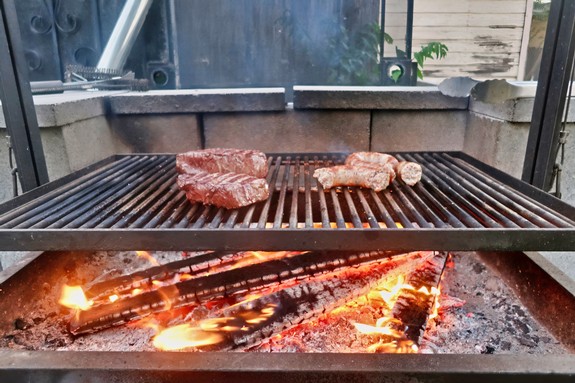
During a meeting of Lodi's Victor Book Club: Perfect opportunity for intense, smoky oak enriched wines (oak grilled Prime beef and local sausages).